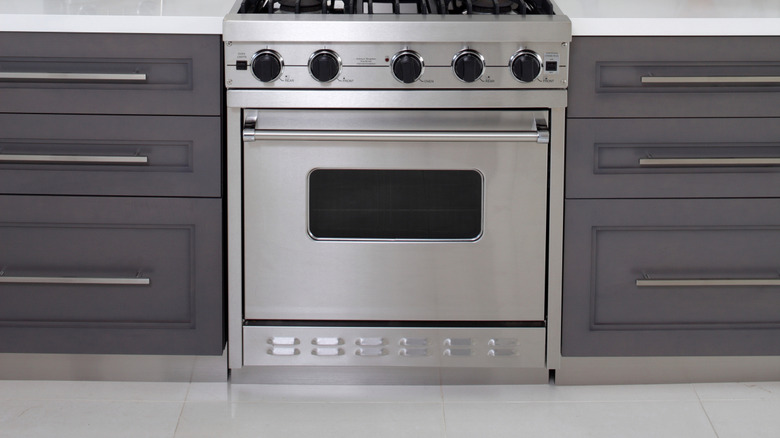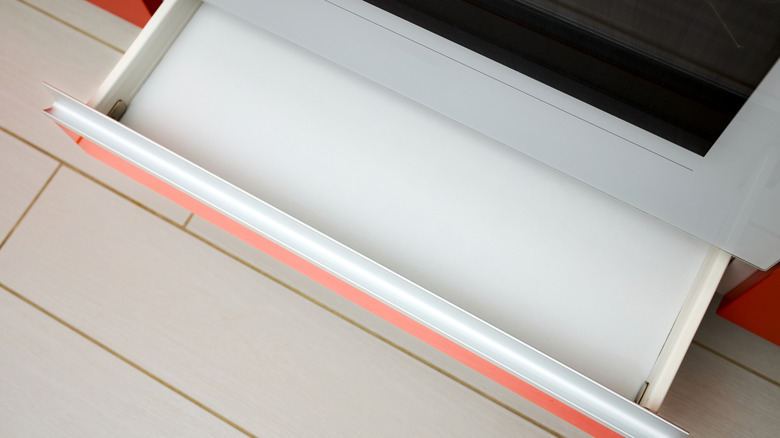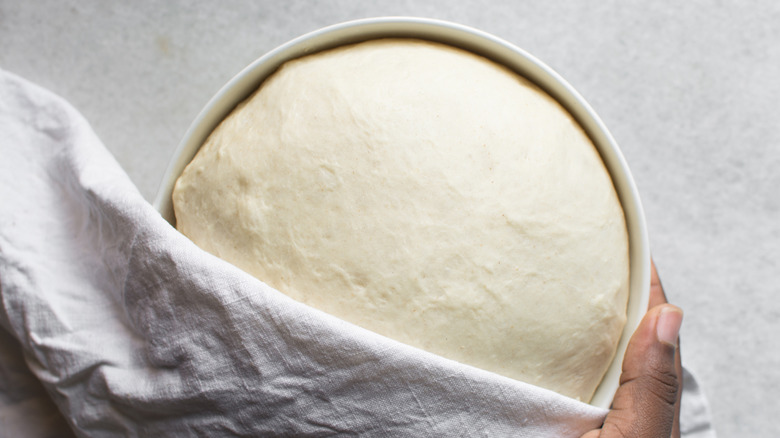The Drawer Under Your Oven Has A Useful Little-Known Purpose
We may receive a commission on purchases made from links.
You've definitely seen and used it before — the handy little drawer right below your oven. In many homes, this spot is the go-to storage zone for baking sheets, muffin tins, or flat pans. But what if we told you that it might actually be intended for more than just storage?
Depending on the model of your stove, this drawer underneath might actually be a "warming drawer" (sometimes also called a baking drawer). While it's easy to overlook, a warming drawer is a surprisingly useful kitchen tool with multiple uses. It essentially maintains a low and steady temperature once the oven is on — typically between 80- and 200-degrees Fahrenheit — meaning it heats up enough to stay warm but doesn't get hot enough to actually cook anything. That same gentle heat can be used to help yeast and dough rise for bread, and to help proof pastries. It can also keep food warm before you serve it, without overcooking or drying it.
Warming drawers are so useful that they're sometimes sold separately on their own, but for certain types of ovens, they're already built in. In other words, you might already have one in your home and not even know it. Here's how to find out.
How to check if your oven has a warming drawer (or just a regular storage drawer)
Sadly, before you get too excited, there's no guarantee that your oven necessarily has a warming drawer. Many ovens do, but definitely not all of them. In some cases, the drawer below your oven is simply storage. Thankfully, there are some easy ways to check whether you have a warming drawer or just a standard storage drawer.
The first step to find out if you have a warming drawer is to check the buttons and settings on your oven. If the drawer is a warming drawer, there should be at least one button labeled — wait for it — "warming drawer." If there's no button to control the drawer's temperature, it's likely just a storage drawer. Sometimes, though, the warming drawer's settings aren't located on the stove's main control panel. In some cases, there may be a knob inside the warming drawer itself. Not having any luck? Don't give up quite yet. It's always a good idea to check your oven's manual to see where to look. And if you're still unsure, the design of the drawer can be a good indicator — does it look like an empty storage space, or does it have racks to hold dishes?
Worst case, even if your electric or gas stove doesn't have a warming drawer but just a standard drawer, it's still a nice plan to store things — as long as those things are oven-safe, since you obviously want to prevent fire hazards in your home. On the other hand, if you do have a warming drawer, you can now elevate your baking game.
How to use your warming drawer like a pro
If your stove has one of the aforementioned knobs or controls, congrats — you have a warming drawer!
To use it properly, there are a few key things to keep in mind. First, just like your oven, the warming drawer needs to be preheated. There are usually three heat settings: low, medium, and high heat. Choosing between temperatures depends on what you need the drawer for. If you're keeping dishes warm without overcooking or drying them out, medium to high heat is best. A range of 140 to 170 degrees Fahrenheit works well for most cooked meals. For heartier dishes, you can go up to 200 degrees Fahrenheit to keep them hot. Only use the warming drawer for one or two hours, though — after that, bacteria might develop on your food. If you're baking and need to proof dough, meanwhile, lower temperatures are ideal.
Maybe you don't have a warming drawer, and all this is making you jealous? If so, just look for it the next time you want to buy a range. Major products like the THOR Kitchen Professional 36-Inch Electric Range come equipped with this great feature right out the box.


